Number of new constructions increases by 7.6 percent
There were a total of 24,610 new construction projects from approved building permits reported in the country during the fourth quarter of 2011. This number registered an increase of 7.6 percent compared to 22,879 construction projects over the same period in 2010 (see Table A).
Residential type building construction in the fourth quarter of 2011 slightly went up by 4.5 percent to 17,451 from 16,697. Similarly, non-residential building construction for the period exhibited a growth of 9.7 percent to 3,407 from 3,106 projects (see Table A).
Furthermore, combined number for additions, alterations and repairs of existing structures showed a 22.0 percent increment to 3,752 from 3,076 recorded during the same quarter of 2010 (see Table A). Figure 1 compares the number of new construction projects for the fourth quarters of 2010 and 2011.
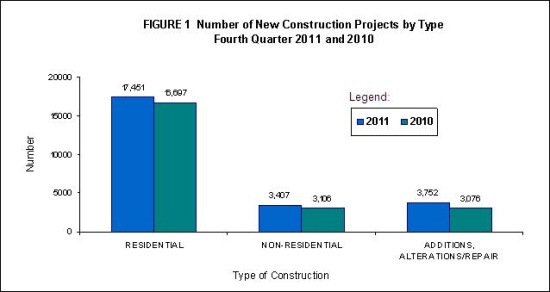
At the regional level, the most number of construction projects were located in the following:
- CALABARZON with 5,489, (22.3%)
- Central Visayas with 3,015, (12.3%)
- National Capital Region (NCR) with 2,718, (11.0%)
- Central Luzon with 2,241, (9.1%)
- Davao Region with 2,027, (8.2%).
For areas outside NCR, three provinces listed below contributed the biggest share in terms of the number of construction projects during the fourth quarter 2011. These provinces recorded number of construction projects exceeding a thousand mark.
- Cavite with 1,970, (8.0%)
- Cebu with 1,334, (5.4%)
- Laguna with 1,289, (5.2%).
Figure 2 displays the distribution of new construction projects by region.
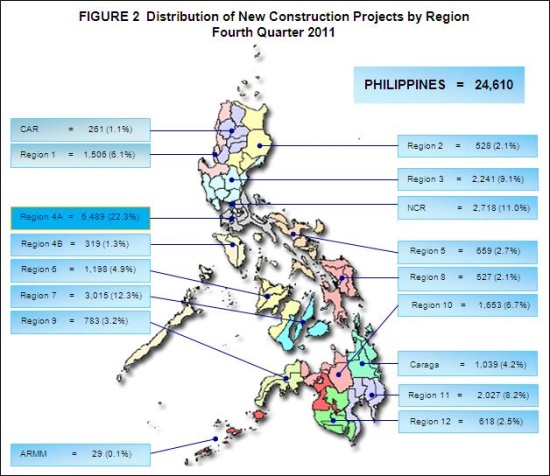
Value of construction projects slumps by 8.5 percent
Aggregate value of construction projects during the fourth quarter of 2011 slumped 8.5 percent to PHP43.8 billion from PHP47.8 billion posted during the same quarter of 2010.
Value of construction for residential buildings showed a decrease of 7.1 percent to PHP24.3 billion from PHP26.2 billion during the same period of 2010.
Likewise, value for non-residential building construction, fell by 14.1 percent to PHP15.7 billion from PHP18.2 billion registered during the same quarter of 2010.
On the other hand, combined value of construction for additions, alterations and repairs of existing structures, estimated at PHP3.8 billion, rose 10.9 percent from PHP3.4 billion registered during the same period of 2010. Figure 3 compares the aggregate value of construction by type of building for the fourth quarters of 2010 and 2011.
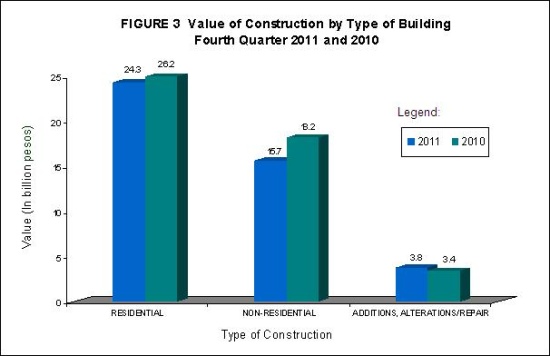
Across the country, NCR consistently occupied the top spot in terms of the value of construction with share of 36.7 percent (PHP16.1 billion) of the total. CALABARZON and Central Visayas ranked second and third with respective shares of 13.9 percent (PHP6.1 billion) and 11.9 percent (PHP5.2 billion).
Average cost per square meter of residential building construction is PHP9,209
Total value of construction for residential buildings was PHP24.3 billion with a total floor area of 2.6 million square meters, translating to an average cost of PHP9,209 per square meter. This figure represents an increase of 5.4 percent compared with the average cost of PHP8,735 per square meter of the previous year.
Comprising about 88.4 percent of the total residential constructions were single-type residential buildings. This type of construction numbered 15,422 projects with a total floor area of 1.4 million square meters and an aggregate value of PHP11.2 billion. This translates to an average cost of PHP7,867 per square meter.
Number of apartment/accessoria-type buildings reached 1,443, representing 8.3 percent of the total residential construction. This type had an estimated construction value of PHP3.2 billion with total floor area of 458.9 thousand square meters or an average cost of PHP7,055 per square meter.
Duplex-type residential construction recorded a total of 494 buildings or 2.8 percent of the total residential construction. Total value for this type amounted to PHP449.6 million and a total floor area of 53.6 thousand square meters or an average cost of PHP8,387 per square meter. Figure 4 displays the percentage distribution of the number and value of residential building construction by type for the fourth quarter of 2011.
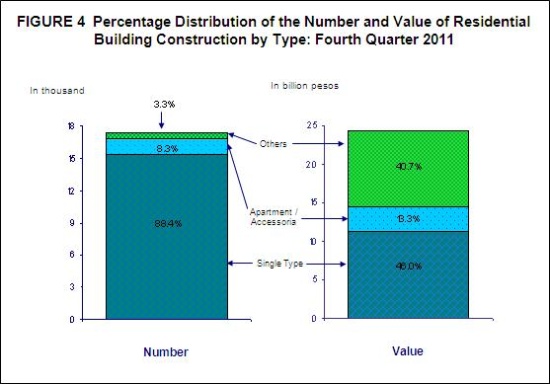
Commercial type non-residential building construction constitutes 58.9 percent
The total value of non-residential building constructions reached PHP15.7 billion with a total floor area of 1.9 million square meters reflecting an average cost of PHP8,342 per square meter.
Commercial-type buildings numbering to 2,007 constituted more than half (58.9%) of the total non-residential constructions. Value of construction for this type was estimated at PHP9.6 billion covering a total floor area of 1.2 million square meters or an average cost of PHP8,101 per square meter.
Institutional building construction reported a total of 584 projects (17.1%) with construction value of PHP3.4 billion and a total floor area of 286.4 thousand square meters or an average cost of PHP11,863 per square meter.
One in every ten (10.6%) non-residential constructions was for industrial-type building with 362 construction projects. The total value of industrial construction amounted to PHP2.0 billion with a total floor area of 325.9 thousand square meters. This translates to an average cost of PHP6,038 per square meter.
The least number of non-residential constructions was reported for agricultural-type building with 99 or 2.9 percent of the total. Construction value was estimated at PHP304.3 million covering a total floor area of 79.1 thousand square meters, indicating an average cost of PHP3,845 per square meter. Figure 5 shows the number and value of non-residential building construction by type for the fourth quarter of 2011.
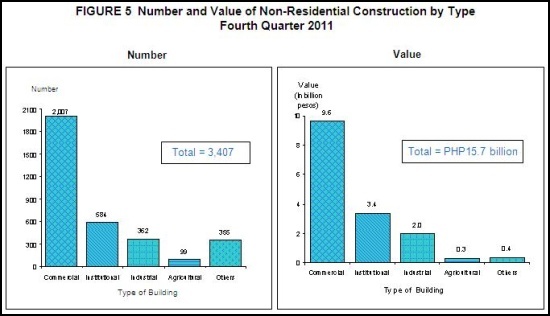
TECHNICAL NOTES
Scope and Coverage
Private construction statistics from approved building permits relate to data on new constructions and additions, alterations and repairs of existing residential and non-residential buildings and other structures undertaken in all cities/municipalities of the country.
For this publication, data for the provinces of Basilan (excluding Isabela City), Lanao del Sur, Masbate and Sulu are not included in the tabulation as these provinces did not submit building permit documents and/or certification of no construction before the deadline. However, if any, these are to be included in the annual tabulation.
Source of Information
Construction statistics are compiled by the National Statistics Office (NSO) from the copies of original application forms of approved building permits as well as from the demolition permits collected every month by NSO field personnel from the Offices of Local Building Officials (LBOs) nationwide.
Limitations:
- Data on private building constructions refer to those proposed to be constructed during the reference period and not to construction work completed during the reference period.
- The completeness of the number of building permits collected relies on the approval of applications filed with the Office of Local Building Officials (LBOs). Hence, private building constructions without approved building permits are excluded from the tabulation of data.
Geographic Classification
Private building constructions are classified and presented by geographic area using the Philippine Standard Geographic Classification (PSGC). The PSGC contains the latest updates on the official number of regions, provinces, cities, municipalities and barangays in the Philippines. It consists of 17 administrative regions as approved under Executive Order No. 36 dated 19 September 2001 (Providing for the Reorganization of the Administrative Regions in Mindanao) and Executive Order No. 103 dated 17 May 2002 (Dividing Region IV into Region IV-A and Region IV-B, transferring the province of Aurora to Region III).
The geographic codes are in accordance with NSCB Resolution No. 3, Series of 2005 that approved the PSGC.
Industry Classification
Private building construction statistics utilizes the amended 1994 Philippine Standard Industrial Classification (PSIC) to classify the main activity through the use or type of occupancy of the building.
Definition of Terms:
Building permit is a written authorization granted by the Local Building Official (LBO) to an applicant allowing him to proceed with the construction of a specific project after plans, specifications and other pertinent documents have been found to be in conformity with the National Building Code (PD 1096).
Building refers to any independent, free-standing structure comprised of one or more rooms or other spaces, covered by a roof and enclosed with external walls or dividing walls, which extend from the foundation to the roof.
Construction refers to an all on-site work done from site preparation, excavation, foundation, assembly of all the components and installation of utilities and equipment of buildings/structures.
Residential building is a building for which its major parts or more than half of its gross floor area is built for dwelling purposes. This type of building can be of the single type, duplex, an apartment and/or accessoria and residential condominium.
Single house is a complete structure intended for a single family or household, i.e. bungalow, 2-storey house, nipa hut.
Duplex house is a structure intended for two households, with complete living facilities for each; it is a single structure divided into two dwelling units by a wall extending from the floor to the ceiling.
Apartment is a structure, usually of two storeys, made up of independent living quarters, with independent entrances from internal walls and courts.
Accesoria is a one or two-floor structure divided into several dwelling units, each dwelling unit having its own separate entrance from the outside.
Residential condominium is a structure, usually of several storeys, consisting of multiple dwelling units.
Other residential constructions consist of school or company staff houses, living quarters for drivers and maids and guardhouses.
Non-residential building includes these type commercial, industrial, agricultural and institutional buildings.
Commercial buildings refer to office buildings and all buildings which are intended for use primarily in wholesale, retail and service trades; i.e. stores, hotels, restaurants, banks, disco houses, etc.
Industrial buildings are all buildings used to house the production, assembly and warehousing activities of industrial establishments; i.e. factories, plants, mills, repair shops, machine shops, printing press, storage plant, electric generating plants.
Institutional buildings are buildings which primarily engaged in providing educational instructions and hospital/health care; ports, airports and other government buildings; i.e. school, museums, libraries, sanitaria, churches, hospitals.
Agricultural buildings are buildings used to house livestocks, plants and agricultural products such as barn, poultry house, piggeries, stables, greenhouses and grain mill.
Other non building constructions include cemetery structures, street furniture, waiting sheds, communication towers, etc.
Addition refers to any new construction which increases the height or area of an existing building/structure.
Alteration is a construction in a building/structure involving changes in the materials used, partitioning and location/size of openings, structural parts, existing utilities and equipment but does not increase the overall area thereof.
Repair is a remedial work done on any damaged or deteriorated portion/s of a building/structure to restore its original condition.
Demolitions refer to the systematic dismantling or destruction of a building/structure or in part.
Street furniture are street structures consisting of monuments, waiting sheds, benches, plant boxes, lampposts, electric poles and telephone poles.
Floor area of building refers to the sum of the area of each floor of the building measured to the outer surface of the outer walls including the area of lobbies, cellars, elevator shafts and all communal spaces in multi-dwellings. Areas of balconies are excluded.
Total value of construction refers to the sum of the cost of building, electrical, mechanical, plumbing, and others. The value is derived from the approved building permit and represents the estimated value of the building or structure when completed.
Unpublished Data:
Unpublished data at the municipal level may also be made available upon request from the Industry Statistics Division, National Statistics Office, 4th Floor Solicarel Bldg. II, Ramon Magsaysay Blvd. Sta. Mesa, Manila, and Tel no. 716-39-32.
